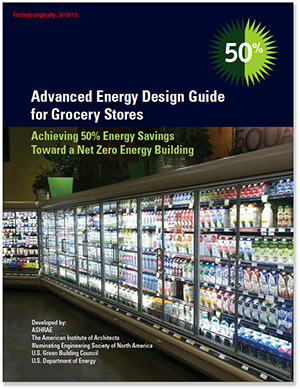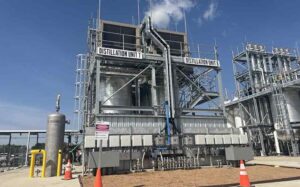Guide looks for 50% supermarket energy cuts
6th April 2015 USA: A new design guide for convenience stores and supermarkets provides recommendations to achieve 50% energy savings when compared with minimum US code requirements.
USA: A new design guide for convenience stores and supermarkets provides recommendations to achieve 50% energy savings when compared with minimum US code requirements.
While the guide applies to US grocery stores with gross floor areas between 25,000 and 65,000ft² with medium- and low-temperature refrigerated cases and walk-ins, many of the recommendations may also be applied to smaller or larger grocery stores.
Today’s stores often include a wide range of prepared food services and expanded fresh food products, which creates unique challenges in the design process due to the needed balance between refrigeration, food service and HVAC systems. “When coupled with the need to create an inviting environment and positive shopping experience for customers, energy efficiency may get overlooked,” say the authors of the report, but argue that “an energy efficient grocery store design adds value, reduces expenses and enhances the customer shopping experience.”
The Guide is the fifth in a series to provide recommendations for achieving 50% energy savings over the minimum code requirements of ANSI/ASHRAE/IESNA Standard 90.1-2004, Energy Standard for Buildings Except Low-Rise Residential Buildings. In the case of this Guide, all recommendations also meet or exceed Standard 90.1-2013.
The series was developed by a committee representing a diverse group of energy professionals drawn from ASHRAE, the American Institute of Architects (AIA), the Illuminating Engineering Society (IES), the US Green Building Council (USGBC) and the Department of Energy (DOE). Support and funding was provided by DOE through the National Renewable Energy Laboratory (NREL).
“Traditionally, the refrigeration and food service are considered independently from the rest of the building systems and the HVAC&R is expected to meet the loads,” Paul Torcellini, chair of the committee that wrote the guide, said. “An integrated approach looks at the building holistically and addresses issues such as: HVAC humidity levels that are critical to the performance of the refrigeration system, refrigeration system waste heat that can be used for hot water or conditioning the outside air, and food service operation that generates lots of heat that must be removed. Adding doors to refrigerated cases reduces uncontrolled cooling, simplifies temperature control and reduces system load. Better management of exhaust hoods and better selection of equipment reduces the food service loads. Proper introduction of outside air that is semi-conditioned helps minimise cooking smoke and odours with minimal conditioning. These are just examples of how the pieces need to work together.”
The specific energy-saving recommendations are summarised in a single table for each US climate zone and allow contractors, consulting engineers, architects, and designers to easily achieve advanced levels of energy savings without detailed energy modelling or analyses.
In addition, this Guide discusses principles of integrated design and how they can be used to implement energy-efficient strategies. A chapter addressing design philosophies for grocery stores is also included. This chapter is devoted to interaction between refrigeration and other building systems.
An expanded section of tips and approaches is included in the “How to Implement Recommendations” chapter. These tips are cross-referenced with the recommendation tables. This chapter also includes additional “bonus” recommendations that identify opportunities to incorporate greater energy savings into the design of the building.
Case studies and technical examples throughout the Guide illustrate the recommendations and demonstrate the technologies in real-world applications.
This guide’s electronic copy has navigational hyperlinks to allow easy movement throughout the guide. Links in the recommendation tables direct readers to the applicable “how to” tips, and links within the text direct to referenced tables and figures.
To download a free copy, please visit www.ashrae.org/freeaedg.







